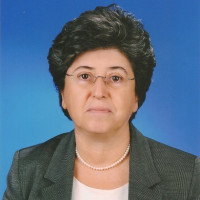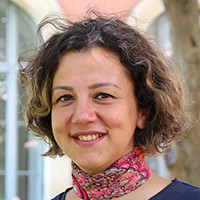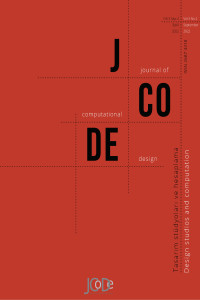JCoDe: Journal of Computational Design (Hesaplamalı Tasarım Dergisi)
AUTHOR GUIDELINES
1. DELIVERY OF ARTICLES
Articles written in Turkish and English can be published in the journal. An extended abstract is a must for manuscripts in Turkish, while an abstract in Turkish is optional for manuscripts in English. The extended abstract is required to reach a larger target group. The extended abstract should not exceed one page about 500 words. The articles should be prepared according to the presentation format of the journal and the necessary arrangements can be requested from the authors.
2. PREPARATION OF ARTICLES
It is requested ethical principles and publication policy agreement, similarity report, cover page (with author information), and manuscript (without author information) as four separate files.
2.1 Ethical Principles and Publication Policy Agreement
The ethical principles and publication policy agreement can be downloaded from the link below and a scanned version of the signed agreement is acceptable.
2.2 Similarity Check Report
According to the new regulation of DergiPark, the similarity report must be received (via Turnitin or iThenticate).
2.3 Cover Page (including author information)
The cover page should be prepared as a separate Word document and should state that the manuscript has been written and approved by all authors and that it is an original, unpublished work not even under review. It should contain the names and signatures of all authors. The scanning of the cover letter is acceptable.
The cover page should contain a brief and informative title; all authors' names, ORCID numbers, institutions/organizations (department, faculty, university, city, and country) and e-mail addresses, and the name and the phone number of the corresponding author. If the manuscript sent has been presented at any meeting before, the name, date, and city of the meeting should be specified.
You can access the template for the cover page from the link below.
2.4 Blinded Manuscript (without author information)
The article should be prepared by following both English and Turkish abstracts, keywords, article, quote (if any), references list in a single Word document. There should not be any information revealing the identity of the authors. The blinded manuscript should have a maximum of 5 keywords that should be sorted alphabetically and separated by commas. Keywords should be chosen carefully to make it easier for readers to search. The abstracts in Turkish should not exceed 250 words and should include the purpose, method, and main findings of the article. The Turkish abstract is optional, while English extended abstract is an obligatory. The extended abstract in English should be about one-page long maximum with 500 words. The extended abstract should mention the research problem, research question, hypothesis, purpose, scope, and methodology within the materials and tools used in the study, the study outcomes, and contribution to the literature. In both abstracts, the authors should avoid giving information that would reveal their identity. The abstracts in both languages should be written in font Calibri Light, single line with 9 pt. font size.
The main text should be 11-point Calibri Light and the line spacing should be 1.15. Except for the summary section, 1 line space should be left between paragraphs. The main title of the article should be written in 20-point and left-aligned, bold (first letters capital). The title and subtitles of the article should be numbered hierarchically as 1., 1.1., 1.1.1 (excluding references). Except for the main title, all titles should be written in Calibri with 12 font size. All letters of primary titles must be in capital letters and bold. In secondary titles, only the first letters should be capitalized. 1 line space is not left after the secondary headings. References should be written in Calibri Light 10 font size. All pages should be numbered consecutively. The length of the manuscript should not exceed 5000 words.
The length of the text should not exceed 5000 words (excluding tables, figures, pictures) including the references. The article must be between 5000 words long (excluding abstract). In the article, any information that could indicate the author’s identity should be removed. Both in the figures and tables within their captions, any identical information should be removed. To maintain the anonymity in double-blind review process, for self-citations, the author surname should be removed and indicated as “(Author(s), year)”. The author can rectify the citations and identical information in the revision process. Symbols, abbreviations and conventions in papers must follow the recommended SI Units. Abbreviations must be defined in brackets after their first mention in the text in accordance with internationally agreed rules. For citation in the text, the referee surname and published year of the reference should be given in the parenthesis (Author, year) in accordance to APA 7 referencing style. The proofing language should be English (United States).
Please click here for the template of the manuscript.
3. REFERENCES
It is encouraged to use APA 7th Edition as a formatting guideline of references. The style is exemplified below. Further details about the APA reference styling is available at http://www.apastyle.org/
In the references in the article, the surname of the author, the year of publication, and the page should be given in parentheses (Author’s surname, Year, p:).
A list of all sources used should be given in alphabetical order according to the surname of the author and in chronological order for each author at the end of the main text in accordance with the following examples. If there is more than one work of the same author of that year in the references used, it should be shown in 2018a, 2018b, 2018c.
Books
Author, A. (Year). Title of the book, City of publication, Publisher.
For a chapter in a book; Author, A. (Year). “Publication name”, Ed: Editor Surname, A., Name of the Book in which it was published, City of publication, Publisher, p: xx-xx.
Ewert, E.W., Mitten, D.S., & Overholt, J.R. (2014). Natural environments and human health. CAB International. https://doi.org/10.1079/9781845939199.0000
Foxall, G. R. (2018). Context and cognition in consumer psychology: How perception and emotion guide action. Routledge.
Schmidt, N. A., & Brown, J. M. (2017). Evidence-based practice for nurses: Appraisal and application of research (4th ed.). Jones & Bartlett Learning, LLC.
Journals
Author, A. A., Author, B. (Year). Article title. Title of the Journal, volume (issue), p: xx-xx.
Ashing‐Giwa, K. T., Padilla, G., Tejero, J., Kraemer, J., Wright, K., Coscarelli, A., Clayton, S., Williams, I., & Hills, D. (2004). Understanding the breast cancer experience of women: A qualitative study of African American, Asian American, Latina, and Caucasian cancer survivors. Psycho‐Oncology, 13(6), 408-428. https://doi.org/10.1002/pon.750
Washington, E. T. (2014). An overview of cyberbully in higher education. Adult Learning, 26(1), 21–27. https://doi.org/10.1177/1045159514558412
Moody, M. S. (2019). If instructional coaching really works, why isn’t it working? Educational Leadership, 77(3), 30–35.
Dayton, K. J. (2019). Tangled arms: Modernizing and unifying the arm-of-the-state doctrine. The University of Chicago Law Review, 86(6), 1497–1737. https://bit.ly/2SkWwcy
Conference papers
Author, A. A., Author, B. (Year, Conference Dates). “Paper title”, Symposium Booklet Name (if any), p: xx-xx, Name of the Symposium, City where it was held. URL
Mason, I. & Missingham, R. (2019, October 21–25). Research libraries, data curation, and workflows [Paper presentation]. eResearch Australasia Conference, Brisbane, QLD, Australia. https://bit.ly/2RGcFdn
Thesis
Author, A. A. (Year, Month Date). Title of the thesis [Unpublished doctoral thesis or master thesis, Name of the Institution, Name, and Location of the Program]. (Name of the Thesis Advisor).
Internet resources should be given at the end of the bibliography list and under a separate title as follows:
Author, A. (2011). Document title [Format description]. Retrieved from https: // URL (access date).
Institution / Organization name (http://www.xxx.xxx), (access date).
Valentin, E. R. (2019, Summer). Narcissism predicted by Snapchat selfie sharing, filter usage, and editing [Master’s thesis, California State University Dominguez Hills]. CSU ScholarWorks. https://scholarworks.calstate.edu/concern/theses/3197xm925?locale=en
Lope, M. D. (2014). Perceptions of global mindedness in the international baccalaureate middle years program: The relationship to student academic performance and teacher characteristics (Order No. 3682837) [Doctoral dissertation, University of Maryland]. ProQuest Dissertations and Theses Global.
Andrea, H. (2014). Effective networked nonprofit organizations: Defining the behavior and creating an instrument for measurement (Doctoral dissertation). https://etd.ohiolink.edu/
Report
Author, A. A. (Year, Month Date). The name of the job. (Report No. 123). Place: Publisher.
Author, A. A. (Year, Month Date). Name of the job (Report No. 123). Name taken from website: https: //www.xxxxxxxx.pdf (access date).
Los Angeles County Department of Public Health. (2017, January). Key indicators of health by service planning area. http://publichealth.lacounty.gov/ha/
4. TABLES AND FIGURES
Figures should be placed on the template to fit in 11 or 17 cm wide columns. If the size of the table or figure exceeds the width of the paragraph 11 cm, it is placed so that it is justified on both sides. Each figure, table, and picture are written in the text, regardless of the heading and subtitle numbers in the section where it is written, as Figure 1, Figure 2, Figure 3, Table 1, Table 2 etc. It should be named and enumerated in order. It should be shown in bold in the text. Table and figure names should be written in Calibri Light 10 font size.
In addition, figures must be uploaded in a zip file with a resolution of at least 300 dpi and in jpeg/tiff format.
For all tables, figures, and pictures that are not belonging to the authors but previously published by other sources, permission should be obtained from the persons who have the right to publish and the permission document should be sent with the article.
5. MATH FORMULAE
The mathematical equations are submitted as editable text and not as images. The equations should be presented in line with normal text where possible, not as an image. In principle, variables are to be presented in italics. Number consecutively any equations that must be displayed separately from the text (if referred to explicitly in the text). Each equation should be presented in the text as Equation 1, Equation 2, etc.
x+y=z (1)
a:b=c (2)
6. BOOK REVIEWS AND NOTES
A book review should be between 500 and 1000 words, which includes the scope of an assessment of the book and its contribution to knowledge and discussion in the context of computational design, architecture, planning, and design. Comments should be written using an 11-point Calibri font with 1.15 line spacing. The name, institution, and e-mail address of the person making the book review should be given. Book cover photo must be provided in jpeg format. Title, author, source, publisher, date, number of pages, price, and ISBN number should be provided as in the example below.
Name of the Book, Name of the Author, Publication Year, Publisher, City, Number of Pages, Price, Type of Volume, ISBN no.
7. REVISION STAGE
Minor revisions must be uploaded to the DergiPark system no later than 10 days after the referee returns. This period is 15 days for major revisions.
8. PUBLICATION FEES
Journal of Computational Design (JCoDe) does not charge for the articles.






